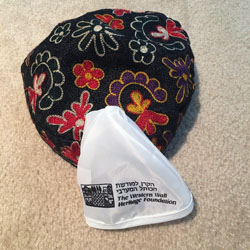© Oliver B. Pollak

 RICHMOND, California — Kippot are among the dozen or so things I have mindlessly acquired over the years. Orthodox Jews cover their heads in public and in worship as a sign of humility before God. Conservative Jews and increasingly Reform Jews cover their heads in synagogues and temples.
RICHMOND, California — Kippot are among the dozen or so things I have mindlessly acquired over the years. Orthodox Jews cover their heads in public and in worship as a sign of humility before God. Conservative Jews and increasingly Reform Jews cover their heads in synagogues and temples.
We acquire skullcaps, yarmulkes, kippot at Bar and Bat Mitzvahs, weddings, birthdays, and historic anniversaries. They are handed to us upon entering the building. They pile up inconspicuously at home. We save things because it does not seem right to get rid of them. We could leave them at the synagogue, but somehow the aura and ambiance of the event suggests that it was designed as a takeaway, a memento. We could take them back to the synagogue to be used by other worshipers who arrive without head cover. They could come in handy along with Haggadahs at Passover. We could drop them off at another synagogue and plant a mystery. Trashing them evokes disrespect and bad luck. They are not genizah type material.
Some yarmulkes have textual identification and are works of stitchery embroidered art with gold and silver thread. Some made from knitted wool, linen, or leather, may also proclaim sports loyalties like Dodgers or Yankees, but most clearly, Jew. Kids make them in summer camp. Kids bring gifts from their summer in Israel. Not quite a T shirt, Kippot for events send the message, this event is special, its memorable.
My kippot are predominantly from Omaha and a smattering from Council Bluffs, Chicago, Winnipeg, and Jerusalem.
Most of my yarmulkes come from Bar and Bat Mitzvahs. Seven are from Bar and two from Bat Mitzvahs, the latter occurring in Palo Alto and Memphis. Our oldest kippah is from my wife’s brother, Marty, Martin Goldstein, 1962, probably purchased at the House of Israel on Wilshire Boulevard. We have several from our younger son’s bar mitzvah, Aaron Pollak, in 1988. For some families we have attended coming of age rituals and weddings; and weddings followed by their children’s coming of age.
It’s a nice touch to evoke Jewishness to honor the event, honoree and guests at publicly celebrated birthdays of individuals and institutions. I have kippot from the Omaha B’nai B’rith Centennial, February 5, 1989; B’nai Israel Synagogue, Council Bluffs, 100th anniversary, June 4-6, 2004; and a 75th birthday of a friend in 2015.
Kippot are nice to commemorate a wedding. Most couples are still married and alive, the longest for 24 years. There are none from my 1968 wedding or Noah’s 1984 Bar mitzvah. Mortuaries offer generic black yarmulkes, with the name of the funeral home, not the decedent.
Synagogue and Jewish museum gift shops, Judaica stores and online retailers have a wide selection of kippot. Women are increasingly wearing kippot along with prayer shawls or tallitim.
All kippot are special. I have two standouts. At the Passover Seder I wear my ‘freedom kippah’ given to me in the early 1980s by a grateful Russian emigrant for some legal work I did in his behalf. Alex Shtromberg, came to San Francisco from Odessa in 1979. Alex is machitonim, father of my daughter-in-law Marianna. He related “This skullcap (I believe is called “tubete” in Uzbek and “tubeteyka” in Russian) is widely used in all former USSR middle Asian, mostly Muslim, republics and regions (Uzbekistan, Tadzhikistan, Bashkiria, Chechnya, Turkmenistan etc.) When they are individually handmade in the family the ornaments usually have some meaning. They became very popular in Russian speaking republics as well as after WWII in late 1940’s through 1960’s when evacuees started returning home to territories that were occupied by Germans. It was mass produced in Odessa, the city of my birth and was not unusual for the boys of my age in late 1950’s to wear them in summer camps.”
On my first trip to Israel, in 2014, I went to the Wall and was handed a Western Wall Heritage Foundation commemorative kippah. an affectionate reminder of my visit.
Accumulating and letting go. Your feelings of what is meaningful may not be shared by your intimates. Kippot keepers are anachronisms. Kippot yellowing from age await their fate at the bottom of the box. Children and grandchildren may retain the keeper kippot. I don’t expect them to fight over it.
.
Pollak, a professor emeritus of history at the University of Nebraska at Omaha, is a freelance writer now based in Richmond, California. He may be contacted via oliver.pollak@sdjewishworld.com